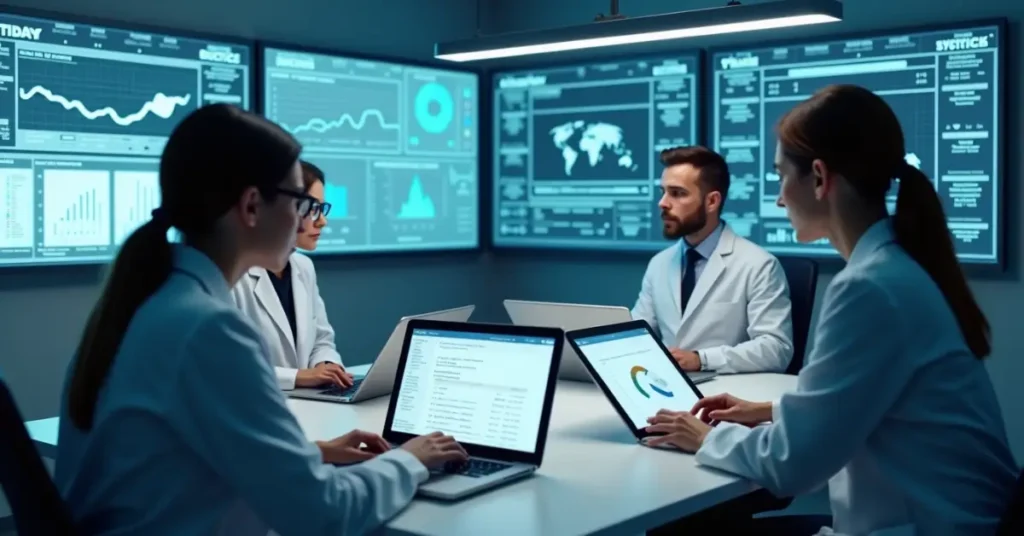
In this article:
- CTMS and EDC Roles in Clinical Trials
- How to Integrate CTMS and EDC Systems Successfully
- Key Benefits of CTMS and EDC Integration in DCTs
- Conclusion: Improving Clinical Research With Smarter Integration
- FAQs About CTMS and EDC Integration
- Improved Security and Compliance Readiness
- Does Integration Affect the Financial Management of a Clinical Trial?
- What Role Does CTMS and EDC Integration Play in Risk-Based Monitoring?
- Is It Possible to Integrate EDC With Other Systems Besides CTMS?
- Can CTMS and EDC Integration Support Remote Monitoring by Sponsors or CROs?
Managing a clinical trial involves more than just collecting data; it requires careful planning and execution. It also involves tracking sites, schedules, and progress to ensure everything runs smoothly. That’s where tools like CTMS and EDC come in.
A Clinical Trial Management System (CTMS) facilitates trial operations, while an Electronic Data Capture (EDC) system manages participant data. They’re both useful, but when they aren’t connected, things can become confusing or inefficient. This is especially true in decentralized trials, where teams and data are spread across different locations.
That’s why CTMS and EDC integration is becoming a key part of running efficient and reliable clinical trials. In this article, we’ll explore what each system does, how to integrate them effectively, and the main benefits for teams working in clinical research.
CTMS and EDC Roles in Clinical Trials
A Clinical Trial Management System (CTMS) helps research teams stay organized. It tracks recruitment, visit schedules, site activity, and key milestones. This makes it easier to manage the progress of clinical trials.
An EDC system is used for the electronic capture of data. It collects clinical data from participants, often through online forms, apps, or wearable devices. This system is designed to reduce manual data entry and improve data accuracy.
Both tools are important. While CTMS focuses on operations, the EDC handles incoming trial data. Used together, they help teams manage both the workflow and the study’s results.
Challenges in Decentralized Trials Without Integration
In decentralized trials, CTMS and EDC systems typically operate independently. When teams are not connected, they face challenges in clinical trial data management that impact both efficiency and data integrity.
Common issues include:
- Data silos between systems make it harder to get a full view of the trial
- Duplicate data entry wastes time and increases the risk of errors
- Delays in reporting, especially when updates aren’t shared across platforms
- Inaccurate or outdated clinical data can lead to missed safety alerts or decisions based on old information
To avoid these setbacks, teams should consider a connected approach to clinical trial data integration. It lays the groundwork for smoother collaboration, more accurate reporting, and better outcomes in decentralized settings.
How to Integrate CTMS and EDC Systems Successfully
A well-planned CTMS and EDC integration can improve operational efficiency. Below are simple but important steps to help teams connect these systems the right way.
1. Define Clear Integration Goals and Data Flows
Start by setting clear goals for the integration of EDC and CTMS. Decide which data should be shared between systems. This might include visit logs, subject IDs, participant data, or safety reports. Involve teams from different departments such as clinical operations, data management, and IT. Working together early helps avoid confusion during setup.
It is also important to map how data will move across systems. Clear data flows help prevent missing or repeated information when syncing.
2. Standardize Data Fields and Naming Conventions
For systems to work together, they must follow the same format. Align field types, labels, and units. For example, both systems should treat dates, visit codes, or lab values the same way. Using a standard like CDISC 1 helps maintain consistency across systems. This reduces the risk of data errors and facilitates more effective data validation.
A common structure makes it easier to track and analyze clinical trial data across sites and tools.
3. Build a Reliable Data Mapping Document
A data mapping document connects the right fields in each system. It shows how data from the EDC software matches with fields in the clinical trial management system. This document should include field names, types, and extra notes or metadata. Keeping it updated helps teams avoid mismatched entries and ensures a smoother process.
Share the mapping with all involved teams. This encourages consistency, even if the systems or study needs change later.
4. Set Up Real-Time Data Exchange and Monitoring
Real-time syncing is one of the most useful parts of a good CTMS integration. It lets teams view updates as they happen, which supports faster responses and safer trials. Use API connections or other automation tools to allow real-time data to flow between systems. This cuts down on delays and avoids manual updates.
Having real-time data validation in place also helps catch errors quickly. This is especially useful for remote data capture in decentralized clinical trials.
5. Prioritize Data Security and Regulatory Compliance
Protecting clinical data is critical. Use tools like encryption, password controls, and activity tracking to reduce the risk of data breaches. Follow industry rules such as GCP, HIPAA, and FDA 21 CFR Part 11 2 to stay compliant. These frameworks are designed to protect patient data and ensure the integrity of your study.
It is also helpful to maintain an audit trail for all updates made through integrated systems. This builds trust and shows that your processes meet quality standards.
Key Benefits of CTMS and EDC Integration in DCTs
Below are some of the key benefits of integrating EDC and CTMS for research teams operating across multiple sites and systems.
Real-Time Insights and Faster Decision-Making
When systems are connected, teams get access to real-time data. This means updates on participant data, site activity, or safety events are available as they happen.
In a remote setting, this helps teams act quickly. For example, if a wearable device reports a sudden change in health, researchers can respond without waiting for manual updates. This level of visibility supports faster decision-making and keeps the study on track.
Better Data Integrity and Fewer Errors
Integration helps eliminate manual data entry, which is often slow and prone to mistakes. With information shared directly between systems, the likelihood of missing or duplicate entries decreases.
It also helps maintain data integrity. The same values appear across platforms, making it easier to follow the study protocol and support data validation. When both systems reflect the same clinical trial data, it’s easier to trust the results.
Smoother Workflows and Easier Collaboration
With connected systems, teams no longer need to check and update the same data in different places. This reduces extra steps and improves workflow across departments.
Both clinical operations and data management teams can access shared records. Everyone works from the same system, which supports better coordination and fewer miscommunications.
Improved Security and Compliance Readiness
An integrated system gives teams more control over who can view or change sensitive information. Features like audit trails and permission settings help track user activity and support internal reviews.
Integration also makes it easier to meet regulatory compliance standards such as GCP or FDA 21 CFR Part 11. Having a clear view of data movement and security helps protect patient data and maintain study integrity.
Conclusion: Improving Clinical Research With Smarter Integration

Connecting CTMS and EDC systems allows research teams to manage clinical trial processes more effectively. It improves data quality, lowers the chance of errors, and helps teams respond faster when issues arise. With integrated tools in place, teams can stay focused on the study itself rather than spending time on system-related fixes.
A strong integration also helps streamline workflows, improve site performance, and facilitate better communication across teams. Whether your trial is remote or in-person, connected systems make daily operations more manageable and more reliable.
If your team is looking for a way to enhance trial oversight and simplify complex data tasks, a platform like CDConnect™ can help. It brings together device data, operations, and analysis in one place, built for secure, real-time research.
FAQs About CTMS and EDC Integration
Does Integration Affect the Financial Management of a Clinical Trial?
It can. Some CTMS platform features include budgeting, payments, and invoice tracking. When integrated with EDC systems, teams can link patient data or visit logs to payment milestones. This helps keep financial records in sync with actual trial activity and improves oversight.
What Role Does CTMS and EDC Integration Play in Risk-Based Monitoring?
Risk-based monitoring depends on the early detection of trends or anomalies. When your CTMS and EDC are connected, you get a clearer view of participant progress, missed visits, or outlier data. This helps prioritize monitoring efforts and respond before issues grow.
Is It Possible to Integrate EDC With Other Systems Besides CTMS?
Yes. While this article focuses on CTMS and EDC integration, EDC software can also connect with platforms like eTMF, lab systems, or eConsent tools. These connections allow for more streamlined data flows across the whole ecosystem of a trial.
Can CTMS and EDC Integration Support Remote Monitoring by Sponsors or CROs?
Yes. Integration allows sponsors or CROs to access up-to-date information across systems without needing constant manual updates. With centralized dashboards and real-time data, stakeholders can track progress, monitor site performance, and respond to issues even if they’re off-site.
Sources: